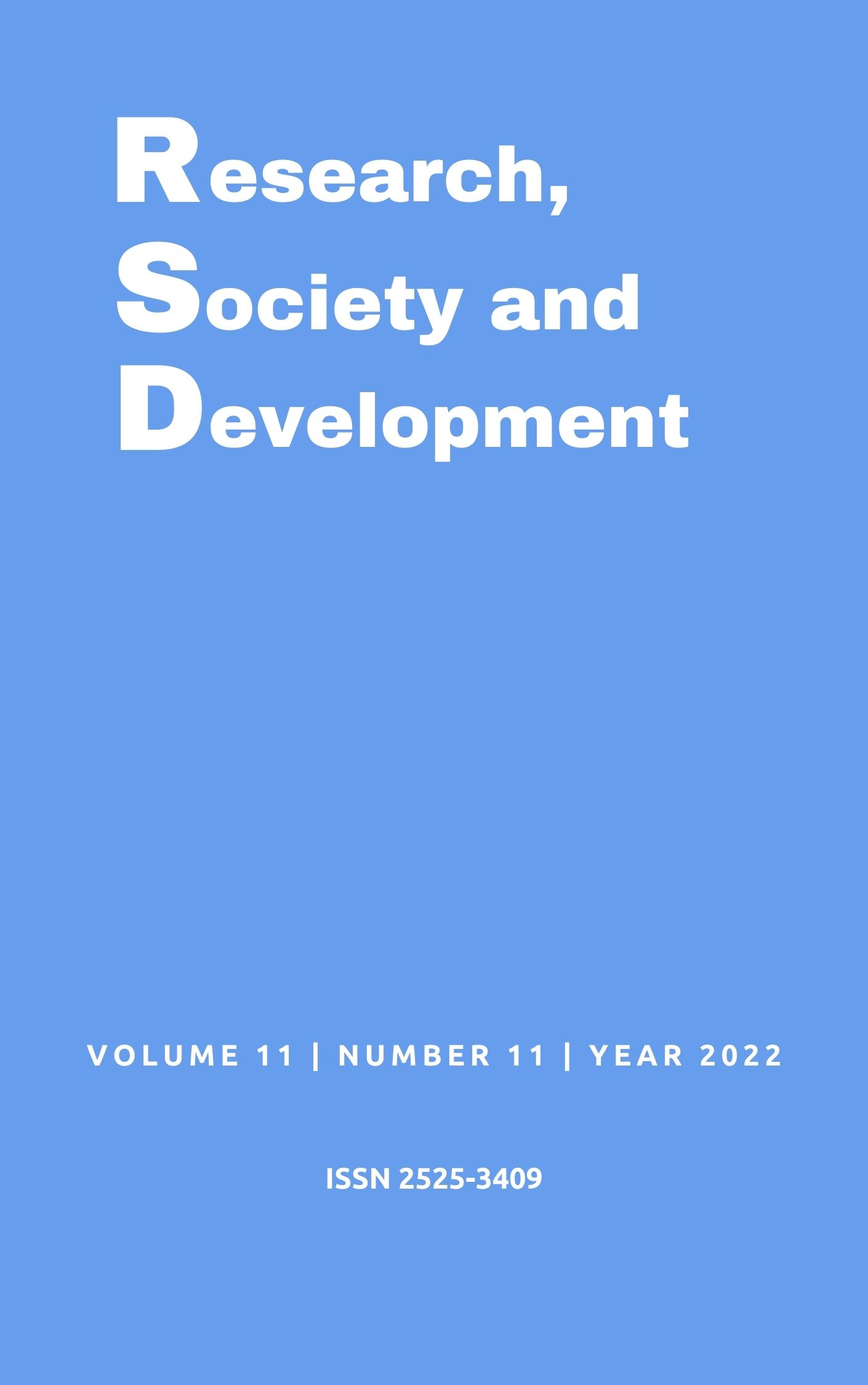Alcançando a compreensão da leitura por meio da instrução integrada de vocabulário
DOI:
https://doi.org/10.33448/rsd-v11i11.33528Palavras-chave:
Leitura tradicional, Compreensão literal, Proficiência, Iniciantes, Língua estrangeira.Resumo
A leitura e o vocabulário há muito são considerados uma conexão intrínseca para ajudar os alunos a adquirir a língua, mas a literatura sugere o vocabulário como um recurso fundamental para garantir a compreensão da leitura. Este estudo, advindo de uma pesquisa de dissertação de mestrado, tentou explicar os ganhos e percepções do ensino integrado de vocabulário no desempenho da compreensão leitora. Para cumprir o objetivo do estudo, sessenta e seis alunos de nível A1 de inglês de uma escola pública rural em seu primeiro ano de ensino médio foram selecionados e distribuídos em dois grupos (tradicional e integrado). Todos os participantes participaram de oito aulas de leitura com a instrução de vocabulário designada. Após cada aula, eles participaram de um teste de compreensão de leitura baseado em questões de compreensão literal. Além disso, ao final da pesquisa, foram levantadas as percepções do grupo experimental (instrução integrada). Depois de analisar os dados, este estudo descobriu que a instrução integrada de vocabulário pode levar a uma maior realização de compreensão de leitura em um nível iniciante de proficiência. Além disso, este trabalho de pesquisa propõe um extenso estudo sobre os benefícios da instrução integrada ao trabalhar com níveis superiores de proficiência.
Referências
Bachowickz, C., Fisher, P., & Ogle, D. (2006). Vocabulary: Questions from the classroom. Reading Research Quarterly, 41(4), 524-539. doi:10.1598/RRQ.41.4.5
Basaraba, D., Yovanoff, P., Alonzo, J., & Tindal, G. (2012). Examining the structure of reading comprehension: do literal, inferential, and evaluative comprehension truly exist? Reading and Writing, 26(3), 349-379. doi:10.1007/s11145-012-9372-9
Berne, J., & Blachowicz, C. (2008). What Reading Teachers Say about Vocabulary Instruction: Voices From the Classroom. The Reading Teacher, 62(4), 314-323. doi:10.1598/RT.62.4.4
Bryman, A. (2012). Social Research Methods (4th ed.). New York, NY: Oxford University Press.
Golonka, E., Bowles, A., Silbert, N., Kramasz, D., Blake, C., & Buckwalter, T. (2015). The Role of Context and Cognitive Effort in Vocabulary Learning: A Study of Intermediate-Level Learners of Arabic. The Modern Language Journal, 99(1), 19-39. doi: 10.1111/modl.12191
Engku, E., Sarudin, I., & Muhamad, A. (2016). The Relationship between Vocabulary Size and Reading Comprehension of ESL Learners. English Language Teaching, 9(2), 116-123. doi:10.5539/elt.v9n2p116
Ehri, L.(2022). What Teachers need to know and to teach letter-sounds-phonemic awareness, Word reading, and Phonics. The Teacher Reader, 76(1), 53-61. doi:101002/trtr.2095
Khazaal, E.(2019). Impact of Intensive Reading Strategy on English for Specific Purposes College Students' in Developing Vocabulary. Arab World English Journal, 10(2), 181-195.doi: https://dx.doi.org/10.24093/awej/vol10no2.15
Kung, F. (2017).Teaching second language reading comprehension: the effects of classroom materials and reading strategy use. Innovation in Language Learning and Teaching, 1-12.doi: 10.1080/17501229.2017.1364252
Golonka, E., Bowles, A., Silbert, N., Kramasz, D., Blake, C., & Buckwalter, T. (2015). The Role of Context and Cognitive Effort in Vocabulary Learning: A Study of Intermediate-Level Learners of Arabic. The Modern Language Journal, 99(1), 19-39. doi: 10.1111/modl.12191
Grabe, W. (2004). Research on Teaching Reading. Annual Review of Applied Linguistics, 24, 44-69. doi:10.1017/S0267190504000030
Grabe, W. (2017). L2 reading comprehension and development. In E. Hinkel (Ed.), Handbook of research in second language teaching and learning, 3, 299-311.
Gungor, F., & Yayh, D. (2016). The Interplay between Text-based Vocabulary Size and Reading Comprehension of Turkish EFL Learners. Educational Sciences: Theory and Practice, 16(4), 1171-1188. doi:10.12738/estp.2016.4.0078
Hamzehlou, S., Zainal, Z., & Ghaderpour, M. (2012). A Review on the Important Role of Vocabulary Knowledge in Reading Comprehension Performance. Procedia: Social and Behavioral Sciences, 66, 555-563. doi:10.1016/j.sbspro.2012.11.300
Harmer, J. (2007). How to Teach English. Harlow, England: Pearson Education Limited.
Mackey, A.,& Gass, S.(2005). Second Language Research: Methodology and Design. Mahwah, NJ: Lawrence Erlbaum Associates
Nation, P. (2009). Teaching ESL/EFL Reading and Writing. New York: Routledge.
Naeimi, M., & Chow, T. (2015). Vocabulary Acquisition through Direct and Indirect Learning Strategies. English Language Teaching, 8(10), 142-151. doi:10.5539/elt.v8n10p142
Olmez, F. (2016). Exploring the Interaction of L2 Reading Comprehension with Text- and Learner-related Factors. Procedia: Social and Behavioral Sciences, 232, 719-727. doi:10.1016/j.sbspro.2016.10.09
Oslund, E. & Elleman, A.(2019). Reading Comprehension Research: Implications for Practice and Policy.Policy Insights from the Behavioral and Brain Sciences, 6(1),3-11. https://doi: 10.1177/2372732218816339 journals.sagepub.com/home/bbs
Wright, T. S., & Cervetti, G. N. (2017). A systematic review of the research on vocabulary instruction that impacts text comprehension. Reading Research Quarterly, 52(2), 203–226. https://doi.org/10.1002/rrq.163
Zucker, T. Cabell, S., & Pico, D.(2021). Going Nuts for Words: Recommendation for Teaching Young Students Academic Vocabulary. The Reading Teacher, 74(5), 581-594. doi: 10.1002/trtr.1967
Downloads
Publicado
Edição
Seção
Licença
Copyright (c) 2022 Gabriela Gáleas Arboleda; María Angélica Rivadeneira Zambrano; Luis Alfredo Camacho Castillo; Jardel Coutinho dos Santos

Este trabalho está licenciado sob uma licença Creative Commons Attribution 4.0 International License.
Autores que publicam nesta revista concordam com os seguintes termos:
1) Autores mantém os direitos autorais e concedem à revista o direito de primeira publicação, com o trabalho simultaneamente licenciado sob a Licença Creative Commons Attribution que permite o compartilhamento do trabalho com reconhecimento da autoria e publicação inicial nesta revista.
2) Autores têm autorização para assumir contratos adicionais separadamente, para distribuição não-exclusiva da versão do trabalho publicada nesta revista (ex.: publicar em repositório institucional ou como capítulo de livro), com reconhecimento de autoria e publicação inicial nesta revista.
3) Autores têm permissão e são estimulados a publicar e distribuir seu trabalho online (ex.: em repositórios institucionais ou na sua página pessoal) a qualquer ponto antes ou durante o processo editorial, já que isso pode gerar alterações produtivas, bem como aumentar o impacto e a citação do trabalho publicado.


